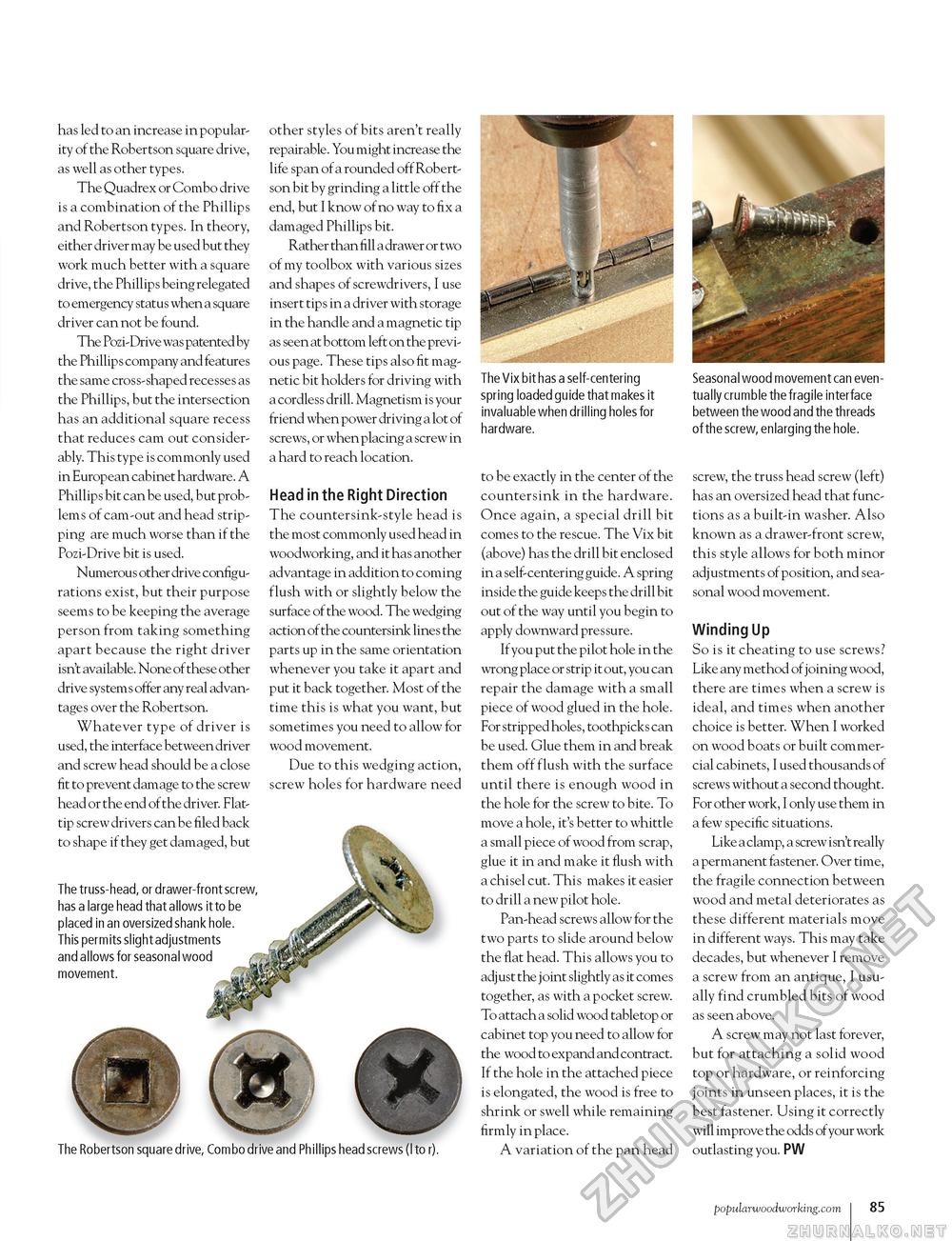Popular Woodworking 2006-02 № 153, страница 84
has led to an increase in popularity of the Robertson square drive, as well as other types. The Quadrex or Combo drive is a combination of the Phillips and Robertson types. In theory, either driver may be used but they work much better with a square drive, the Phillips being relegated to emergency status when a square driver can not be found. The Pozi-Drive was patented by the Phillips company and features the same cross-shaped recesses as the Phillips, but the intersection has an additional square recess that reduces cam out considerably. This type is commonly used in European cabinet hardware. A Phillips bit can be used, but problems of cam-out and head stripping are much worse than if the Pozi-Drive bit is used. Numerous other drive configurations exist, but their purpose seems to be keeping the average person from taking something apart because the right driver isn't available. None of these other drive system s offer any real advantages over the Robertson. Whatever type of driver is used, the interface between driver and screw head should be a close fit to prevent damage to the screw head or the end of the driver. Flat-tip screw drivers can be filed back to shape if they get damaged, but The truss-head, or drawer-front screw, has a large head that allows it to be placed in an oversized shank hole. This permits slight adjustments and allows for seasonal wood movement. other styles of bits aren't really repairable. You might increase the life span of a rounded off Robertson bit by grinding a little off the end, but I know of no way to fix a damaged Phillips bit. Rather than fill a drawer or two of my toolbox with various sizes and shapes of screwdrivers, I use insert tips in a driver with storage in the handle and a magnetic tip as seen at bottom left on the previous page. These tips also fit magnetic bit holders for driving with a cordless drill. Magnetism is your friend when power driving a lot of screws, or when placing a screw in a hard to reach location. Head in the Right Direction The countersink-style head is the most commonly used head in woodworking, and it has another advantage in addition to coming flush with or slightly below the surface of the wood. The wedging action of the countersink lines the parts up in the same orientation whenever you take it apart and put it back together. Most of the time this is what you want, but sometimes you need to allow for wood movement. Due to this wedging action, screw holes for hardware need The Robertson square drive, Combo drive and Phillips head screws (l to r). The Vix bit has a self-centering spring loaded guide that makes it invaluable when drilling holes for hardware. to be exactly in the center of the countersink in the hardware. Once again, a special drill bit comes to the rescue. The Vix bit (above) has the drill bit enclosed in a self-centering guide. A spring inside the guide keeps the drill bit out of the way until you begin to apply downward pressure. If you put the pilot hole in the wrong place or strip it out, you can repair the damage with a small piece of wood glued in the hole. For stripped holes, toothpicks can be used. Glue them in and break them off flush with the surface until there is enough wood in the hole for the screw to bite. To move a hole, it's better to whittle a small piece of wood from scrap, glue it in and make it flush with a chisel cut. This makes it easier to drill a new pilot hole. Pan-head screws allow for the two parts to slide around below the flat head. This allows you to adjust the joint slightly as it comes together, as with a pocket screw. To attach a solid wood table top or cabinet top you need to allow for the wood to expand and contract. If the hole in the attached piece is elongated, the wood is free to shrink or swell while remaining firmly in place. A variation of the pan head Seasonal wood movement can eventually crumble the fragile interface between the wood and the threads of the screw, enlarging the hole. screw, the truss head screw (left) has an oversized head that functions as a built-in washer. Also known as a drawer-front screw, this style allows for both minor adjustments of position, and seasonal wood movement. Winding Up So is it cheating to use screws? Like any method of joining wood, there are times when a screw is ideal, and times when another choice is better. When I worked on wood boats or built commercial cabinets, I used thousands of screws without a second thought. For other work, I only use them in a few specific situations. Like a clamp, a screw isn't really a permanent fastener. Over time, the fragile connection between wood and metal deteriorates as these different materials move in different ways. This may take decades, but whenever I remove a screw from an antique, I usually find crumbled bits of wood as seen above. A screw may not last forever, but for attaching a solid wood top or hardware, or reinforcing joints in unseen places, it is the best fastener. Using it correctly will improve the odds of your work outlasting you. PW popularwoodworking.com I 103 |








